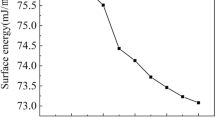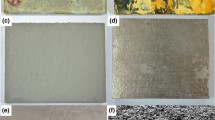Abstract
Aluminum or its alloys have been considered as one of the some important materials in various industries. The wetting durability of the aluminum surface, which is used as industrial components, is an important property. Therefore, if the surface properties of aluminum are to be improved, conventional methods such as polymer coating or plasma treatments have been studied. However, due to the water-soluble property of a polymer coating or the aging effect in low-energy plasma treatment, the wetting durability gradually deteriorates with increasing time and numbers of wet/dry cycles. The wetting durability of an aluminum surface can be improved by treating with a high-current ion beam. In a previous work, the contact angle of an ion-beam-treated aluminum surface was remarkably reduced up to around 20 degrees, and the formation of an AlN (aluminum-nitride) layer with its thickness affecting the wetting durability could be anticipated. However, the factors influencing the wettability of the aluminum surface could not be proven with certainty. In this work, the main factors that affect the wetting durability were determined based on an SEM (scanning electron microscope) analysis as well as supplemental experiments. After ion-beam irradiation, the aluminum surface exhibited a nanostructure composed of compact nanorod arrays with diameters of 10–50 nm through an SEM analysis. In addition, 500 wet/dry-cycle tests were performed to identify the detailed morphology in this work. We could found that a nanorod arrays with sharp tips were regularly arranged on the aluminum surface.
Similar content being viewed by others
References
M. C. Wintersgrill, Nucl. Instr. Meth. B 1, 595 (1984).
R. Flitsch and D. Y. Shi, J. Vac. Sci. Technol. A 8, 2376 (1990).
C. Y. Lee, J. S. Lee, H. J. Choi and J. Y. Song, J. Korean Phys. Soc. 61, 254 (2012).
K. S. Gadre and T. L. Alford, J. Appl. Phys. 93, 919 (2003).
F. M. d’Heurle and J. M. E. Harper, Thin Solid Films 171, 81 (1989).
S. M. Jung, G. S. Chang, J. H. Song, K. H. Chae, K. Jeong, J. J. Woo and C. N. Whang, J. Korean Phys. Soc. 28, 481 (1995).
Lynne M. Svedberg, Kenneth C. Arndt and Michael J. Cima, J. Am. Ceram. Soc. 83, 41 (2000).
P. Bowen, J. G. Highfeld, A. Mocellin and T. A. Ring, J. Amer. Ceram. Soc. 73, 724 (1990).
Author information
Authors and Affiliations
Corresponding author
Rights and permissions
About this article
Cite this article
Lee, CY., Kim, BS., Choi, H.J. et al. Study on factors affecting wetting durability of high current ion-beam treated aluminum surfaces. Journal of the Korean Physical Society 63, 1399–1402 (2013). https://doi.org/10.3938/jkps.63.1399
Received:
Published:
Issue Date:
DOI: https://doi.org/10.3938/jkps.63.1399




